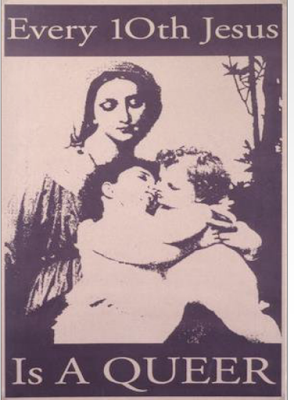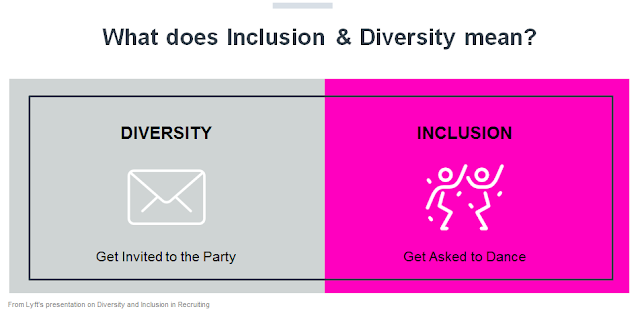~ Audre Lorde
Monday, October 30, 2017
[those of us who stand outside...]
"Those of us who stand outside the circle of this society’s definition of acceptable women; those of us who have been forged in the crucibles of difference – those of us who are poor, who are lesbians, who are Black, who are older – know that survival is not an academic skill. It is learning how to stand alone, unpopular and sometimes reviled, and how to make common cause with those others identified as outside the structures in order to define and seek a world in which we can all flourish. It is learning how to take our differences and make them strengths."
Monday, October 23, 2017
[Jim Fitterling makes the case for LGBTQ+ diversity and inclusion]
"Data suggests that about 75 percent of any organization’s LGBT population remain in the closet … because they’re too scared to come out. I know this from first-hand experience. I was one of those employees."Read the rest of his talk at https://www.vsotd.com/featured-speech/making-small-talk-case-lgbt-diversity-and-inclusion
"Employees who feel connected to the workplace—who feel free to speak their mind without fear of being “outed”—and who feel connected to their co-workers—are more engaged and feel more empowerment.
Ideas flow more genuinely. People trust one another more. Collaboration rises.
Did you know, by the way, that natural work groups perform cognitive tasks 32 percent better when LGBT team members are “out” as opposed to when they are closeted?"
categories:
diversity and inclusion,
embrace,
lgbtq
Wednesday, October 18, 2017
[naming ourselves: who defines Indigenous identity? article]
About identity and names and power....
Recent identifiers such as “Native American,” “Aboriginal,” and “Indigenous” are deceptively vague, attempting to contain all of the complexities and differences of each individual tribe under one umbrella term. The problem with such terms, of course, is that the bigger the group they attempt to represent, the more they erase complexities and differences and encourage homogenization. While grouping all Indigenous tribes and nations together can be convenient, the reason these terms became necessary in the first place is colonialism. Settler governments needed a term to differentiate us from the settler population (i.e., not indigenous to or claimed by a tribe indigenous to Turtle Island) to figure out how to exactly describe the problem we posed to their burgeoning nation-states. We could not be “The Hopitu-Oceti-Sakowin-Kanien’kehá:ka-Powhatan-Chahta-Annishnawbe-Beothuk, etc. problem.” We must be, simply, “The Indian problem.” Bearing that in mind, the question of how to define Native identity should always be split in two: how the government defines us and how we define ourselves.Read the rest of the article at: https://thewalrus.ca/we-didnt-choose-to-be-called-indigenous/
categories:
identity,
indigenous,
power
Tuesday, October 17, 2017
[OpenDyslexic typeface]
 OpenDyslexic is a new open source font created to increase readability for readers with dyslexia. The typeface includes regular, bold, italic, and bold-italic styles. It is being updated continually and improved based on input from dyslexic users. OpenDyslexic is free for Commercial and Personal use.
OpenDyslexic is a new open source font created to increase readability for readers with dyslexia. The typeface includes regular, bold, italic, and bold-italic styles. It is being updated continually and improved based on input from dyslexic users. OpenDyslexic is free for Commercial and Personal use.Available at: https://opendyslexic.org/
Note: there are some book readers which are being designed to allow the user to change various view settings, including font size, font type (the poeticcomputation example offers OpenDyslexic as one option), spacing between lines, and more.
https://www.fastcodesign.com/90144268/designing-a-book-that-fits-in-your-browser-window
http://poeticcomputation.info/ sample site where you can change font to this one, etc.
categories:
disability
Wednesday, October 11, 2017
[every 10th jesus...]
This poster is from the collection of the Center for the Study of Political Graphics.
The title alludes to Alfred Kinsey's work in the 1940s which found that 10% of men in the United States are homosexual. Despite there being significant methodological reasons that this number should not be applied to the general population, the number "10%" has stuck.
From the details page:
By incorporating this statistic into Bouguereau’s traditional religious portrait, Handel challenges the understanding of Christian views on homosexuality. Bouguereau’s idyllic depiction of the affectionate infants Jesus and John the Baptist in the loving embrace of the Virgin Mary evoke Christ's and Mary's love and compassion for all humanity, including the ten percent who may be gay or lesbian. The peacefulness of the scene emphasizes the stark contrast between the great benevolence and love expressed by Christ in the Bible and the hatred and violence directed towards the LGBT community that some attempt to justify with Christian ideology.
Tuesday, October 10, 2017
[answering messages of hate with love]
Here's an innovative and constructive way to deal with racist graffiti:
Ibo Omari has a plan for when he comes across a swastika painted onto a wall in his hometown of Berlin. He’ll grab a can of spray paint from the graffiti supply shop that he owns, and cover it up. But Omari doesn’t just erase the Nazi trademark—he transforms it.
Since launching Berlin #PaintBack earlier this year, Omari and his fellow organizers have covered up at least 20 swastikas across Berlin, leaving an array of whimsical street art where symbols of hate were once visible.
Read more about how #PaintBack is transforming neo-nazi graffiti into whimsical street art.
https://www.citylab.com/life/2016/08/transforming-neo-nazi-graffiti-into-whimsical-street-art/497867/
Here's a Canadian story where a church in Waterloo did something quite similar.
Thursday, October 05, 2017
[what does inclusion and diversity mean?]
I've been keeping an eye out recently for catchy ways of explaining diversity and inclusion, especially in ways that make the distinction clear, and came across this graphic in a presentation by Lyft.
But it begs other questions: Can you dance with whom you wish at this party? Will anyone whisper about you behind your back or jeer at you openly?
Can you be authentic and free to be the person you are without fear?
And here's another set of questioning: who controls the music that is played? whose styles of dance are acceptable?
It's one thing to be invited to someone else's party and to be asked to dance their dances... but is that inclusion? Or is inclusion having a variety of music that reflects everyone's interests and cultures, and enjoying and learning from each other?
Subscribe to:
Comments (Atom)




